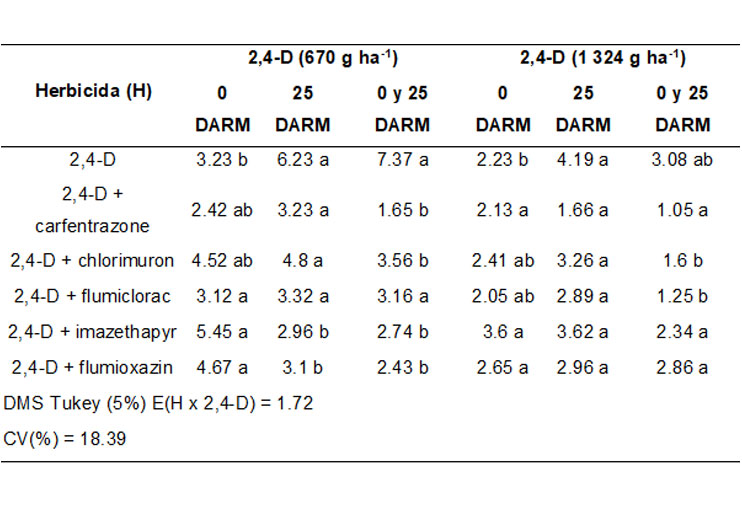Evaluación de tolerancia a glyphosate y glufosinate en retoños de algodón genéticamente modificado
DOI:
https://doi.org/10.29312/remexca.v15i2.3423Palabras clave:
Gossypium hirsutum, destrucción química, glitol, rebroteResumen
La destrucción de la cosecha de tallos de algodón debe realizarse después de esta. Sin embargo, la destrucción por arado impide continuar con la siembra directa, lo que hace que el manejo químico sea un aliado en la conservación del suelo. El objetivo fue identificar la dosis de 2,4-D, asociada a diferentes herbicidas y el momento de administración más eficazes para el control de retoños de algodón transgénico para tolerancia a glyphosate y glufosinate. Los tratamientos consistieron en el uso aislado del herbicida 2,4-D, a dosis de 670 y 1 340 g ha-1, y asociado a los herbicidas carfentrazone, flumiclorac, chlorimuron, flumioxazin y imazethapyr en tres tiempos de aplicación: 0 días después de la siega mecánica (0 DARM), 25 DARM, y 0 DARM + 25 DARM. Se evaluó el rebrote a los 15, 30 y 45 días después de la primera y segunda aplicación. Las evaluaciones de rebrote se realizaron a los 15, 30 y 45 días después de la primera y segunda aplicación, determinando la biomasa seca de los brotes. En cuanto al tiempo de uso de los herbicidas, los mejores resultados se obtienen cuando se suministró 0 DARM +25 DARM. Dosis más altas de 2,4-D (1 324 g ha-1) lo hacen más eficiente relaciona a los herbicidas se percibieron variaciones en su comportamiento según el tiempo de evaluación, la aplicación y la dosis de 2,4 D utilizada. Durante el último período de medición, 45 días después de la aplicación, 2,4-D+carfentrazone y 2,4-D+flumiclorac presentaron las masas secas de yema más bajas. El experimento se llevó a cabo en 2014. Se concluyó que existe una menor tasa de rebrote del algodón cuando se repite la aplicación de los herbicidas 0 DARM y 25 DARM. La dosis de 1 324 g ha-1 de 2,4-D es más eficiente. 2,4-D+carfentrazona y 2,4-D+flumiclorac promovieron una menor masa seca 45 días después de la administración de los tratamientos.
Descargas
Citas
Andrade-Júnior, E. R.; Cavenaghi, A. L. and Guimarães, S. C. 2015. Destruição química da soqueira em variedades de algodoeiro resistentes ao glifosato. Primavera do Leste, IMAmt. Circular Técnica. 8-17 pp.
Andrade-Júnior, E. R.; Cavenaghi, A. L. and Guimarães, S. C. 2016. Destruição química de soqueira em variedades resistentes ao glifosato safra. Primavera do Leste, IMAmt. Circular Técnica. 8-29 pp.
Azevedo, D. M. P.; Cortez, J. R. B. and Brandão, Z. N. 2004. Uso de desfolhantes, maturadores e dessecantes na cultura do algodoeiro irrigado. Campina grande, Embrapa. Circular técnica. 7-78 pp.
Brasil. 2008. Instrução normativa núm. 1524. Regulamento da defesa sanitária vegetal. Dou, 20/08/2008, Seção. 1-2 pp.
Corrêa, J. C. and Gomes, A. C. 2005. Manejo das soqueiras do algodoeiro herbáceo em plantio direto com rotação de culturas nos cerrados. R Ceres. 52(1):739-749. https://www.redalyc.org/pdf/3052/305242983009.pdf
Dayan, F. E.; Duke, S. O.; Weete, J. D. and Hancock, H. G. 1997. Selectivity and mode of action of carfentrazone-ethyl, a novel phenyl triazolinone herbicide. Pest Sci. 51(1):65-73. https://doi.org/10.1002/(SICI)1096-9063(199709)51:1<65::AID-PS598>3.0.CO;2-9.
Embrapa. 2004. Empresa brasileira de pesquisa agropecuária. 2004. Boletim de pesquisa e desenvolvimento. Planaltina, Embrapa Cerrados. 1-15 pp.
Oliveira-Júnior, R. S.; Constantin, J. A.; Costa, J. M.; Cavalieri, S. D.; Arantes, G. Z.; Alonso, D. G.; Roso, A. C. and Biffe, D. C. 2006. Interação entre sistemas de manejo e de controle de plantas daninhas em pós emergência afetando o desenvolvimento e a produtividade da soja. Planta Daninha. 24(4):721-732. https://doi.org/10.1590/S0100-83582006000400013.
Silva, F. A. S. and Azevedo, C. A. V. 2009. Principal components analysis in the software ASSISTAT-statistical assistance. 393-396 pp.
Siqueri, F. V.; Martin, J. B. and Guedes, H. C. 2020. Avaliação de herbicidas para a destruição química de soqueiras do algodoeiro. www.cnpa.embrapa.br/produtos/ algodao/publicacoes/trabalhos-cba4/311.pdf. 1-3 pp.
Vianello, R. L. and Alves, A. R. 2004. Meteorologia básica e aplicações. Viçosa, Universidade Federal de Viçosa. ISBN 85-7269-073-5. 448 p.

Descargas
Publicado
Cómo citar
Número
Sección
Licencia
Derechos de autor 2024 Revista Mexicana de Ciencias Agrícolas

Esta obra está bajo una licencia internacional Creative Commons Atribución-NoComercial 4.0.
Los autores(as) que publiquen en Revista Mexicana de Ciencias Agrícolas aceptan las siguientes condiciones:
De acuerdo con la legislación de derechos de autor, Revista Mexicana de Ciencias Agrícolas reconoce y respeta el derecho moral de los autores(as), así como la titularidad del derecho patrimonial, el cual será cedido a la revista para su difusión en acceso abierto.
Los autores(as) deben de pagar una cuota por recepción de artículos antes de pasar por dictamen editorial. En caso de que la colaboración sea aceptada, el autor debe de parar la traducción de su texto al inglés.
Todos los textos publicados por Revista Mexicana de Ciencias Agrícolas -sin excepción- se distribuyen amparados bajo la licencia Creative Commons 4.0 atribución-no comercial (CC BY-NC 4.0 internacional), que permite a terceros utilizar lo publicado siempre que mencionen la autoría del trabajo y a la primera publicación en esta revista.
Los autores/as pueden realizar otros acuerdos contractuales independientes y adicionales para la distribución no exclusiva de la versión del artículo publicado en Revista Mexicana de Ciencias Agrícolas (por ejemplo incluirlo en un repositorio institucional o darlo a conocer en otros medios en papel o electrónicos) siempre que indique clara y explícitamente que el trabajo se publicó por primera vez en Revista Mexicana de Ciencias Agrícolas.
Para todo lo anterior, los autores(as) deben remitir el formato de carta-cesión de la propiedad de los derechos de la primera publicación debidamente requisitado y firmado por los autores(as). Este formato debe ser remitido en archivo PDF al correo: revista_atm@yahoo.com.mx; revistaagricola@inifap.gob.mx.
Esta obra está bajo una licencia de Creative Commons Reconocimiento-No Comercial 4.0 Internacional.


